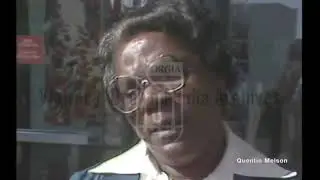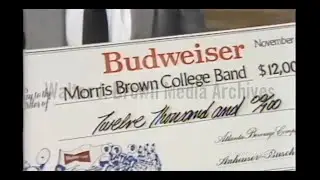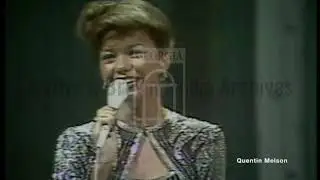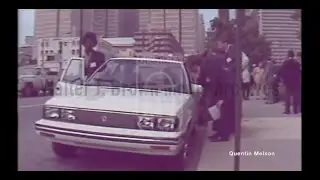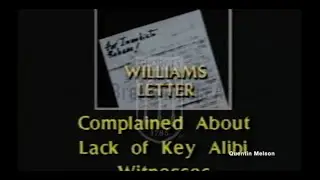The Renault Alliance is Released to the Public (Sept 1, 1982)
David Johnson reports on the release of the Alliance, a new model of car resulting from the merger of American Motors Company and French car manufacturer, Renault. The two automakers teamed up to create a new car that would boost sagging auto sales. Johnson discusses its manufacture in Kenosha, Wisconsin, along with its debut in Atlanta. AMC president Jose Dedeurwaerder admits on camera the company learned some hard lessons from Japanese automakers and the need to play catch up later saying that General Motors’s car, the Chevette, was a car from an old generation. Natural and VoiceOver sound
Reporter: Johnson, David
The Renault Alliance is a front-wheel drive, front-engine subcompact automobile manufactured and marketed in North America by American Motors Corporation (AMC) for model years 1983–1987. The Alliance and its subsequent hatchback variant, the Encore, were re-engineered Renault 9 & 11 for the U.S. and Canadian markets.
Initially available in two- and four-door sedan configurations, three- and five-door hatchback variants (marketed as the Renault Encore) became available in 1984, and a convertible in 1985. AMC also marketed a sports version called Renault GTA for 1987. A total of 623,573 vehicles were manufactured in Kenosha, Wisconsin. Production was discontinued after Chrysler's acquisition of AMC in 1987.
The Alliance and Encore derived from AMC's 1979 partnership with Renault, which held controlling stake in AMC. The cars featured exterior styling by Robert Opron, director of Renault Styling,[3] and interior design by AMC's Dick Teague, with both the Alliance two-door sedan and the convertible body styles uniquely developed by AMC.
Why the Awful, No Good Renault Alliance Was Our 1983 Car of the Year
Allow us to defend the indefensible.
Aaron GoldWriterManufacturerPhotographerMar 29, 2022
The MotorTrend Car of the Year award stretches back some 70 years, and we've taken flak for a few winners, such as the 1974 Ford Mustang II (which we still say was the right car for its time) and the 1991 Chevrolet Caprice (Chevy sent us an LTZ with the police suspension, so it aced the ride-and-handling route). However, few of our winners have drawn as much scorn as our 1983 Car of the Year, the Renault-AMC Alliance.
Honestly, we can't help but wince when people bring up the Alliance, as one auto exec did recently. Still, going back and reviewing the history, we think our early-'80s forebears made the right choice. Step into the MT time machine, and let's take a dive into the circumstances behind the Alliance's 1983 COTY win.
The Times, They Were A-Changin'
Let's start with a quick overview of what was going on in late '82 when we did our 1983 Car of the Year testing. First, fuel economy was of outsized importance. Gas prices had doubled since the 1979 fuel crisis, which had caused rationing and blocks-long lines at gas stations. Second, pop culture loved anything European, and particularly anything French.
SPONSORED CONTENT
How to Know If You’re Overpaying on Car Insurance
By Savvy
And third, and most important, the Alliance's competition was pretty dire.
In 1983, MotorTrend still had separate Car of the Year awards for domestic and imported vehicles, and the Alliance—built in American Motors' Kenosha, Wisconsin, plant with 72 percent U.S. parts content—qualified as a domestic. The industry hadn't yet crawled out of the Malaise Era, and the Alliance faced one of the weakest COTY fields in the award's history. It was competing against just six other cars, and with one possible exception, none was particularly brilliant.
The Contenders For 1983 Car Of The Year
General Motors fielded two cars, the Buick Skyhawk in "Euro-style" T-Type form and the Oldsmobile Firenza GT. (These were badge-engineered versions of the Chevrolet Cavalier, which had competed for COTY in 1982 and finished seventh out of 11 in a surprisingly strong field.) Chrysler sent its new E-Class and Dodge 600 ES, stretched versions of the 1981-COTY-winning K-cars. They marked the beginning of the K-body proliferation, which we very soon grew sick and tired of.
Ford had a rather interesting entrant: the 1983 Thunderbird, featuring rounded aerodynamic styling that we called "one of the most radically restyled bodies to come out of Detroit in the last 25 years." Unfortunately for Ford (and, perhaps, fortunately for AMC and Renault), at the time we performed our Car of the Year testing, the T-Bird was only available with a 114-hp 3.8-liter V-6 engine and an automatic transmission. The V-8, turbo-four, and five-speed manual that would fulfill the Thunderbird's potential were still several months away. FoMoCo also sent the Mercury Marquis Brougham, newly downsized to the Fox platform and a real snoozer.
AMC-Renault's Naturalized Domestic
Against these competitors, the Renault-AMC Alliance was an intriguing proposition.


![Каркас почти готов. [Жизнь в деревне]](https://images.mixrolikus.cc/video/O_PjtUeWc0I)













